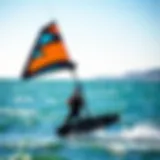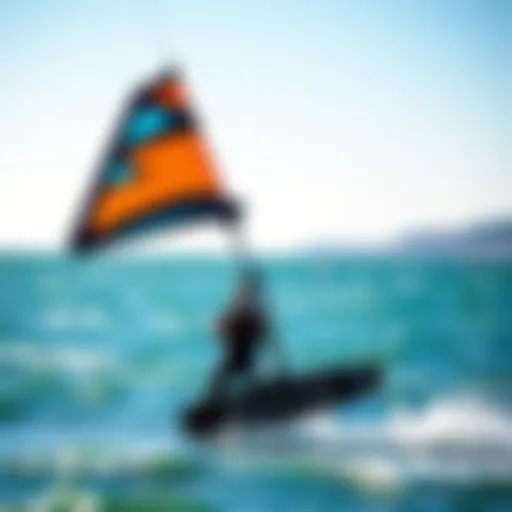Comparing Softshell vs Hardshell Gear in Kiteboarding


Intro
Choosing the right gear for kiteboarding can often feel like navigating choppy waters. The two primary categories of gear, softshell and hardshell, offer various benefits and challenges that can significantly impact your experience on the water. Understanding these differences is key to enhancing both performance and safety.
In this article, we’ll delve into the specifics of softshell and hardshell gear, focusing on factors such as material composition, comfort, and weather resistance. We aim to equip kiteboarders, from novice to expert, with the knowledge they need to make educated decisions tailored to their unique needs and preferences.
By highlighting when to incorporate each type of gear into your kiteboarding day, we will provide clarity on what to consider for different conditions. Whether you’re busily planning a casual session or gearing up for more extreme kiteboarding, the right tools will keep the thrill alive while ensuring you stay safe and sound.
Gear Selection
Selecting the right gear can feel like an art and a science blended together. Each kiteboarding session can be influenced by various elements, including type of kites and the board you choose. These considerations set the stage for either success or struggle on the water.
Types of Kites
When diving into kiteboarding, the types of kites available are abundant. Here’s a quick rundown on the most common ones:
- C-kites: Known for their powerful pull and precision maneuverability, they excel in strong winds. Perfect for free-riders and racing.
- Bow kites: A favorite for beginners, these kites offer an easy setup and stable performance, great for lighter wind conditions.
- Hybrid kites: Carrying traits from both C-kites and bow kites, hybrid options provide balance for varied conditions, making them versatile.
Choosing the right kite boils down to the conditions you expect to face and your personal skill level. Different kites respond differently to wind speeds and maneuvers, so familiarizing yourself with them can be a game changer.
Choosing the Right Board
Next up is the board, which is as essential as the kite. There are a few factors to consider:
- Type of board: Freestyle boards are shorter and offer more pop, while freeride boards focus on comfort and smooth rides over sea choppiness.
- Size: Larger boards provide better floatation, so they can be ideal for lighter wind conditions, whereas smaller boards offer more speed and agility.
Finding the right board can significantly affect your kiteboarding performance. The balance between speed, comfort, and control lies in making the right choice.
Remember: It’s vital to test out different setups if possible. Experience really is the best teacher.
As you consider your gear, think about where you’ll ride and the conditions you expect. Balancing your choices with environmental factors can up your game the moment your feet hit the board.
Foreword to Softshell and Hardshell Gear
When it comes to kiteboarding, the choice between softshell and hardshell gear can make or break your experience out on the water. Both types of gear provide distinct advantages and unique drawbacks, and understanding these differences is crucial for anyone serious about their kiteboarding journey.
Kiteboarding, by its very nature, often finds enthusiasts at the mercy of unpredictable weather. As such, selecting the appropriate gear plays a pivotal role in both performance and safety. Softshells, known for their flexibility and comfort, tend to be favored by riders seeking freedom of movement in milder conditions. Conversely, hardshell gear, designed for harsher environments, provides robust protection against the elements, thus appealing to those who dare to face rough waters and inclement weather.
Let's delve deeper into the nuances of these two gear categories to clarify what each has to offer, and to equip kiteboarders with the knowledge needed to make informed decisions.
Understanding Kiteboarding Gear
Kiteboarding gear encompasses much more than just the kites and boards themselves; it also includes the clothing and protection that ensure both comfort and safety. In the realm of softshell gear, materials are typically lighter and more breathable. This allows for uninhibited movement, which appeals particularly to those who value agility over ultimate weather protection.
In contrast, hardshell gear utilizes thicker, often waterproof materials that excel in shielding the rider from wind, rain, and cold. For example, a kiteboarder facing the bracing winds of late autumn would certainly benefit from a sturdy hardshell jacket that offers insulation and protection from the cold, whereas a warm sunny day might only require a lightweight softshell.
Summarily, both categories of gear will be regularly mentioned as we move through this exploration, each with their specific features that cater to different kiteboarding conditions and styles.
The Importance of Gear Selection
Choosing the right gear in kiteboarding doesn’t just hinge on personal preference; it also depends significantly on riding conditions. Much like a chef chooses his kitchen tools – the right knife for slicing or the correct pot for boiling – a kiteboarder must consider factors like weather, water conditions, and personal riding style before diving into a purchase.
- Comfort and mobility are essential. Whether you're slicing through waves or cruising along calm waters, the right gear should allow you to concentrate on your performance without hindrance.
- Safety aspects cannot be overlooked. A well-chosen piece of equipment can mean the difference between a thrilling adventure and a regrettable mishap.
- Lastly, understanding the value vs. cost is equally important. Often, investing in quality gear results in better long-term satisfaction and safety, while cheaper alternatives may lead to disappointment or worse.
Defining Softshell Gear
In the realm of kiteboarding, equipment choice is at the heart of any successful session. Softshell gear, in particular, plays a significant role in providing comfort and functionality without compromising protection against the elements. Understanding softshell gear extends beyond its surface appearance; it requires a deep dive into its material composition and performance features, which are essential for kiteboarders aiming to strike a balance between agility and adequacy.
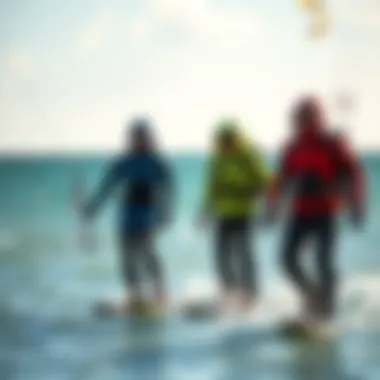

Material Composition
Softshell gear is typically crafted from a blend of synthetic fabrics designed to offer a unique combination of durability and water resistance. Materials such as polyester and nylon are commonly utilized; however, it’s the addition of elements like spandex that bring elasticity into play. This elasticity is what allows softshells to move freely with the user, optimizing both comfort and performance.
Moreover, advancements in textile technology have led to the introduction of softshells with enhanced properties. For instance, Gore-Tex Infinium or similar membranes are sometimes woven into softshells, elevating waterproofing capabilities without sacrificing breathability. Through this creative amalgamation of materials, the outcome is a garment that not only withstands mild rain and wind but enables a kiteboarder to maintain an exceptional range of motion.
"Softshell gear presents an opportunity for kiteboarders to embrace comfort while navigating unpredictable weather."
Breathability and Flexibility
The value of breathability in softshell gear can't be overstated—especially when grabbing wind on a kiteboard. Unlike hardshell options that tend to stifle airflow, softshells are engineered to let moisture escape. This feature is crucial during active sessions, where heat build-up can quickly lead to discomfort.
The flexibility of softshell gear allows kiteboarders to pivot and maneuver seamlessly, whether they're carving through waves or performing tricks. This adaptability is often reinforced by articulated designs and tapered fits, which cater to the dynamic movements involved in kiteboarding. Whether you are a beginner trying to find your balance or an experienced rider executing complicated stunts, the right softshell gear can mean the difference between a frustrating outing and an exhilarating ride.
In essence, softshell gear stands as a testament to the evolution of kiteboarding equipment. By emphasizing material synergy and dynamic design, these garments meet the demands of both performance and comfort in a sport where every second counts.
Characteristics of Hardshell Gear
When diving into the realm of kiteboarding gear, understanding the characteristics of hardshell equipment is crucial for any kiteboarder, from a novice just learning the ropes to a seasoned pro tackling the challenges of extreme conditions. The right gear can make all the difference between a thrilling experience and a potentially dangerous one. Hardshell gear stands out primarily for its durability and structure, offering various benefits that can meet the heavy demands of kiteboarding.
Durability and Weather Resistance
Durability is one of the hallmark traits of hardshell gear. If you're out on the water, the last thing you want is equipment that can't keep up with rough conditions. Hardshell gear, typically crafted from materials such as polycarbonate or molded plastic, is built to withstand the elements. This robustness means they handle impacts better than softshell counterparts, which can be crucial in cases where a wipeout occurs. These hard casings resist abrasions and punctures, ensuring that your gear remains functional over many sessions.
In terms of weather resistance, hardshell gear is designed to be significantly waterproof. When you encounter harsh waves or rain, the protective exterior of hardshell gear helps keep the water out. So, when those dark clouds roll in, and the winds change, you won't have to worry about compromising your comfort or safety. Coupled with sealed seams and specially treated fabrics, many hardshell options are engineered to keep you dry.
"Investing in high-quality hardshell gear isn’t just about performance; it’s about ensuring longevity and reliability on the water."
Weight and Portability
Weight is another aspect to consider when assessing hardshell gear. While this type of equipment may have a reputation for being heavier compared to softshell options, advancements in materials have led to the development of lighter hardshell varieties. Modern hardshell gear often incorporates lighter elements without forsaking strength and protection. Keeping your gear lightweight not only improves your overall experience but makes transport easier, especially if you're traveling to kiteboarding hotspots.
Portability is essential for kiteboarders who may find themselves moving from one launch spot to another. Bulky and heavyweight hardshell gear can become cumbersome, particularly if you're navigating rocky paths or sandy beaches. It's paramount to find that balance between durability and ease of movement. Adopting a lighter yet durable hardshell can offer you the protection you need without adding unnecessary strain when you’re on the go.
Ultimately, understanding the characteristics of hardshell gear forms a foundational aspect of making informed choices in kiteboarding. By appreciating their durability, weather resistance, and evolving weight considerations, kiteboarders can select gear tailored to their specific needs and conditions.
Performance in Different Conditions
When kiteboarding, the conditions become a crucial aspect that can determine the difference between an exhilarating session and a vexing one. Choosing the right gear for the specific environment not only enhances the experience but can be essential for safety as well. This section pulls apart the performance of softshell and hardshell gear in varying conditions, underscoring the pros and cons of each under mild and harsh environments. It's about ensuring that each kiteboarder, from the newbie to the seasoned pro, understands when to reach for the right equipment and why it matters.
Softshell in Mild Weather
Softshell gear shines when kiteboarding in mild weather. The breathable material and flexibility make it a go-to choice for those balmy days when the sun is high, and the winds are just right.
- Breathability: One of the standout features is how softshells allow for ample airflow. When the temperature hovers between 60°F to 75°F, the last thing you want is to feel all bottled up in heavy gear. Softshells wick moisture away while still providing a degree of protection against wind.
- Flexibility: Unlike hardshells, which can feel somewhat restrictive, softshells offer a full range of motion. This free movement is vital for maneuvering the board and adjusting your style according to changing winds.
- Lightweight and Comfort: Softshells tend to be lighter, promoting comfort on those enjoyable, sunny sessions. Wearing one feels more like putting on a second skin than a bulky layer of armor.
Here’s what to keep in mind when considering softshell gear:
- It’s perfect for when you need some protection but not full-on shields against the weather.
- Suitable for spontaneous kiteboarding, where snagging the wind feels liberating rather than daunting.
- However, users should note that in sudden gusts or intermittent rain, softshells may not provide the best defense. In those moments, it could leave you soaked and wishing for more coverage.
Hardshell in Harsh Environments
Now, let’s flip the coin and look at hardshell gear in extreme conditions. When the weather turns unruly, hardshell gear steps up to the plate. This is where it earns its stripes and often becomes a life-saver.
- Durability: Hardshells are built like tanks. In those gnarly conditions—think heavy rain, biting wind gusts, and frigid temperatures—hardshells offer superior protection. They stand firm against abrasive elements that could otherwise ruin your ride.
- Impact Resistance: Kiteboarding can get choppy, especially when the weather doesn’t play fair. Hardshell gear provides a solid barrier, minimizing the risk of injury from falls or collisions with equipment. This is crucial when you’re pushing your skills in rough waters.
- Waterproofing: One of the major benefits that hardshells offer is their waterproof ability. This keeps you dry and warm, which is essential not just for comfort but also for maintaining endurance during challenging sessions.
However, a few caveats deserve mention:
- Hardshells can feel overly rigid, limiting movement compared to softer options. That added safety sometimes comes at the cost of freedom.
- For kiteboarders who prefer agility and swift changes, hardshell might limit fluid transitions and those quick adjustments that can mean the difference between a successful jump or wipeout.
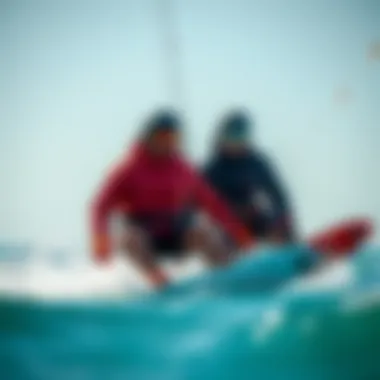

Selecting gear for kiteboarding is about understanding your limits and comfort levels, just as much as it’s about the weather.
Thus, whether leaning toward a softshell for mild conditions or a hardshell in tough environments, it's essential to recognize how conditions shape your performance on the water. Equip yourself wisely, and you’ll find your kiteboarding experience not only safer but also invigorating and enjoyable.
Comfort and Mobility
In the world of kiteboarding, where the thrill of the wind meets the rush of water, comfort and mobility in gear play pivotal roles. These are not just luxurious features; they can be the difference between a memorable session and a frustrating ordeal. Being comfortable in your gear means you can focus on enjoying the ride rather than fidgeting and adjusting your clothing, which could detract from that vital connection between you and the elements.
A kiteboarder gearing up for the day needs equipment that allows freedom of movement. Kiteboarding often requires a range of actions, from jumping and twisting to rapid directional changes. If your gear hinders these movements, it can lead to discomfort or even injuries. Certain materials and designs cater specifically to these needs, providing a better overall experience on the water.
Softshell Comfort Features
Softshell gear has been designed with mobility at its core. This class of equipment commonly utilizes fabrics that stretch and move with the body, ensuring that kiteboarders maintain full range of motion. Here are a few key features:
- Flexible Materials: The fabric used in softshells is often a blend of polyester or nylon with elastane, allowing them to flex without losing structural integrity.
- Lightweight Design: Softshell gear tends to be lighter than its hardshell counterparts, reducing the burden on the rider, especially during prolonged sessions on the water.
- Moisture-Wicking Capabilities: Softshells often come with moisture-management features that help keep the skin dry. This is crucial in maintaining comfort, especially when kiteboarding in warmer conditions.
- Layering Potential: These garments fit snugly without feeling restrictive, making them ideal for layering. A kiteboarder can easily layer a softshell over thermal gear in cooler weather while still enjoying breathability.
In sum, the comfort features integrated into softshell gear allow kiteboarders to concentrate on their performance rather than worrying about their attire.
Hardshell Restrictions
While hardshell gear is geared towards providing maximum protection, it unfortunately does come with its own set of limitations regarding comfort and mobility. Understanding these restrictions is crucial for anyone considering investing in such equipment:
- Reduced Flexibility: Hardshells, made from rigid materials like polycarbonate or thicker nylon, often restrict movement. This can lead to awkward body positioning during tricks or maneuvers.
- Heavier Weight: The sturdy construction adds weight, making these garments feel cumbersome. Kiteboarders may find themselves fatigued more quickly as a result.
- Limited Breathability: Unlike softshells, hardshells can trap heat and moisture, potentially leading to overheating in warmer conditions or discomfort from being clammy.
- Bulkiness in Style: Design-wise, many hardshell items often sacrifice aesthetics for functionality, leaving the kiteboarder with fewer options to express personal style.
This combination of factors implies that while hardshell gear protects against harsh elements, it can inhibit the agility required for kiteboarding. Therefore, choosing hardshell versus softshell gear requires careful consideration of individual priorities—safety or mobility.
"In kiteboarding, it’s not just about the thrill of the ride; it’s also about how your gear works with your body."
For more insights into the best practices for selecting kiteboarding gear and understanding its performance implications, you might explore resources like Wikipedia for historical context and Reddit for community advice.
Safety Considerations
Safety is paramount in kiteboarding, a sport that carries its share of risks. While the thrill of riding the waves and soaring through the air captivates enthusiasts, the importance of Choosing the right gear cannot be overstated. When it comes to safety, both softshell and hardshell gear offer distinct advantages and considerations that every kiteboarder should be aware of.
Padded Protection in Softshells
Softshell gear is often favored for its comfort and flexibility, but its safety features should not be overlooked. Many softshell jackets and pants come equipped with strategically placed padding, which helps protect the wearer from impacts. This padding can absorb shock from falls, crashes, or unexpected encounters with obstacles in the water, such as a wayward board or other riders.
- Lightweight Design: Softshells are generally lighter than their hardshell counterparts, which provides greater range of motion.
- Quick-Drying Materials: Most softshells utilize materials that dry quickly, which minimizes discomfort after a tumble into the water.
- Breathable Functionality: The breathability of softshell gear allows heat to escape during intense rides, reducing the risk of overheating.
While not as rigid as hardshell gear, the added padding in softshells can be a real boon when navigating challenging kiteboarding conditions.
Impact Resistance of Hardshells
When it comes to extreme conditions, hardshell gear truly shines in the realm of impact resistance. Made from robust materials, these pieces are designed to withstand significant force, protecting critical areas during high-speed crashes or turbulent water landings.
- Sturdy Construction: Hardshell gear is built to endure, whether it's sharp objects in the water or rough winds.
- Enhanced Coverage: Most hardshell options offer extended coverage around the torso and limbs, acting as a protective barrier against potential injuries.
- Weather Resistance: Besides impact protection, hardshells also excel in keeping out wind and water, providing a dual layer of safety.
Choosing hardshell gear means opting for a fortress against nature's elements and the potential perils that come with kiteboarding.
Ultimately, the decision between softshell and hardshell lies in a rider's comfort with the risks involved, their environment, and their individual preferences. Both types of gear play a critical role in ensuring a safer kiteboarding experience.
Cost versus Value
When it comes to kiteboarding, understanding the concept of cost versus value can greatly impact your overall experience on the water. It’s not just about how much you’re willing to fork out for your gear but also about what that gear brings to the table in terms of performance, durability, and enjoyment. In this section, we break down the essentials that every kiteboarder should consider when weighing their options for softshell and hardshell gear.
Budgeting for Softshell Gear
Softshell gear often presents a more budget-friendly option in comparison to its hardshell counterpart. This is due to several factors:
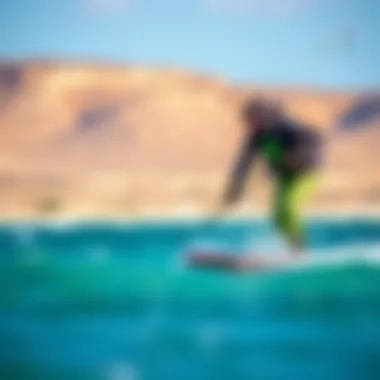

- Material Cost: The materials used in softshell construction tend to be less expensive, making them generally more accessible for those just starting out.
- Versatility: Softshell pieces are known for their flexibility and ease of use across a range of conditions which can reduce the need for multiple investments. It’s kind of a one-stop-shop.
- Affordability for Add-ons: The affordability extends to accessories that might accompany softshell gear. If you need to buy extra items, it doesn’t hit the wallet as hard.
Considerations for Budgeting:
- Frequency of Use: Think about how often you'll be kiteboarding. If you’re planning on hitting the waves regularly, it may be worth investing a bit more in higher-quality softshell gear, as it will likely last longer than a cut-rate option.
- Environment: Consider the conditions in which you'll be kiting. A moderate investment in a decent softshell can save you from costly replacements down the line if you're riding frequently in less than ideal weather.
- Maintenance Costs: Softshell gear often requires less rigorous maintenance, which can save money over time.
With a budget in mind, it's essential to strike a fine balance between what you can afford upfront and what the long-term value of your investment will be. It’s the kind of situation where you sometimes have to spend a little to save a lot.
Investment in Hardshell Gear
On the other hand, investing in hardshell gear can come with a steeper price tag but promises numerous benefits that justify the expense:
- Enhanced Protection: Hardshell gear is usually built to take a beating, providing a higher level of protection against harsh elements like wind and water, and, let’s be honest, crashes.
- Long-Term Durability: When you buy into hardshell gear, you’re often paying for longevity. A quality hardshell might seem like a splurge initially but can save you money in the long run due to its resilience and extended lifespan.
- Specialized Usability: Depending on the type of kiteboarding you plan on doing, certain specialized hardshell gear can enhance your performance significantly, leading to a better overall experience.
Factors to Consider When Investing:
- Performance Requirements: If you're venturing into extreme kiteboarding, the investment in hardshell gear often pays off in performance and safety.
- Potential Resale Value: Quality hardshell gear often retains its value. If you decide to upgrade or switch your setup, you might recoup a decent part of your initial investment.
- Safety Features: Don’t overlook the importance of safety. Sometimes, the difference in gear can be a matter of how well protected you are in unpredictable conditions.
To sum it up, choosing between softshell and hardshell gear really does come down to a careful calculation of costs and benefits. It’s not just about what’s in your wallet today but what’s worth it for the future rides. When you weigh these options, remember that sometimes, the cheapest option can cost you the most in the long run.
"Investing in the right gear is like investing in your own safety and enjoyment on the water."
For more insights into kiteboarding gear costs, check resources like Wikipedia or community discussions on Reddit.
Understanding this balance of cost versus value will serve you well and ensure that your kiteboarding adventures are both thrilling and safe.
Choosing the Right Gear for Your Needs
Selecting the right kiteboarding gear is not just about what looks flashy on the beach or what the latest trends suggest. It’s about performance, safety, and enjoyment during those wind-swept adventures. Both softshell and hardshell gear have their places in the kiteboarder’s arsenal, and understanding how each type fits your needs can make all the difference.
Analyzing Your Kiteboarding Environment
The environment where you intend to kiteboard is paramount in deciding between softshell and hardshell gear. Factors such as wind conditions, water temperature, and geographical features all intertwine to shape your experience.
- Wind Conditions: If you're navigating through mild breezes where flexibility is key, softshell gear thrives. Its ability to stretch and move with your body allows for agile maneuvers. In contrast, when tackling stronger winds, hardshell gear's rigidity provides the much-needed protection against the elements and ensures stability.
- Water Temperatures: Another aspect is the water temperature you’ll be facing. Chilly waters demand insulation, where softshells can provide warmth along with breathability, making them a logical choice. Conversely, hardshell gear can offer complete waterproofing, essential when you’re facing frigid air and water alongside wild gusts.
- Geographical Features: Is your kiteboarding venue dotted with rocks, sharp debris, or just open water? Softshell gear generally offers less impact protection compared to hardshell materials. You might find that a hardshell suit can be an invaluable layer of defense when riding near rocky outcrops or other hazards.
Considering Personal Preferences
Your personal preferences dictate a lot about how much you enjoy the sport. What feels comfortable to you? Are you the type who enjoys the freedom of movement, or do you prefer a structured fit?
- Comfort vs. Security: Some kiteboarders may prefer the snug feeling of softshell gear. It wraps around the body closely, allowing for complete freedom of motion and often comes with a plush interior feel. Meanwhile, others may opt for hardshell, reveling in the security of its encasing, particularly during high-impact sessions.
- Style and Fit: There’s no shame in caring about how your gear looks. Aesthetics play a role in confidence on the water. Softshells can provide a sleek appearance with various colors and styles, while hardshells often boast a robust look focused more on functionality. Whatever the case, choose gear that resonates with your personal style.
Future Trends in Kiteboarding Gear
The landscape of kiteboarding gear is constantly evolving, shaped largely by advancements in technology and an increasing awareness of environmental issues. Understanding future trends can provide kiteboarders with valuable insights into making informed gear choices that not only enhance performance but also address the shifting dynamics of consumer preferences. In this section, we will examine two key trends: technological advancements in materials and the significant considerations surrounding environmental impact and sustainability.
Technological Advancements in Materials
The kiteboarding industry is experiencing a significant shift towards innovative materials that enhance both performance and durability. Manufacturers are investing in research and development to craft equipment that can withstand the rigors of diverse kitesurfing conditions.
- Lightweight Composites: Brands are experimenting with lightweight composites that do not compromise on strength. Materials such as Dyneema and advanced nylons are becoming more common. These not only improve maneuverability but also reduce fatigue on long sessions.
- Water-Repellent Technologies: New water-repellent finishes are being developed, which help fibers retain less water. This means the gear stays lighter, allowing kiteboarders to perform better, especially during extended sessions in wet conditions.
- Responsive Performance Fabrics: Fabrics designed to enhance stretching and recovery are emerging, enabling better fit and comfort without losing functionality. This is crucial for high-performance kiteboarders who require freedom of movement.
"As the demand for higher performance and greater comfort in kiteboarding gear grows, so too does the investment in cutting-edge technologies that respond to these needs."
The trend toward advanced materials is proving to be beneficial not just for the rider's experience, but also in terms of safety. Gear that's better designed and constructed can lead to fewer injuries and more enjoyable experiences on the water.
Environmental Impact and Sustainability
With the growing emphasis on sustainability, both manufacturers and consumers are becoming increasingly aware of their environmental footprint. Kiteboarding gear production can have a significant negative impact due to materials and manufacturing processes. As such, many companies are now prioritizing sustainable practices.
- Recycled Materials: Several brands are now using fabrics made from recycled plastics, reducing waste and promoting a circular economy. This resonates well with environmentally-conscious riders who prefer to support brands with eco-friendly missions.
- Sustainable Production Methods: Innovations in production techniques, such as reduced energy consumption during manufacturing and lower water usage, are being implemented. These changes not only benefit the planet but can also lead to cost savings for the manufacturers, which might eventually be passed onto consumers.
- Lifecycle Assessment: A focus on lifecycle assessment encourages companies to consider the total environmental impact of their products, from production to disposal. Gear designed with end-of-life in mind can ultimately lessen the ecological footprint of the sport.
As consumers become more savvy about their environmental impact, this push for sustainability is likely to influence not just purchasing decisions but also brand loyalty in the kiteboarding community. Kiteboarders are increasingly choosing to invest in brands that align with their values, encouraging a shift towards more responsible practices.
Understanding these trends will be essential for kiteboarders of all skill levels to not only select gear that meets their needs but also to support the ethical shifts in the industry. As technology continues to evolve and sustainability takes center stage, the kiteboarding gear market is likely to transform significantly in the coming years.






